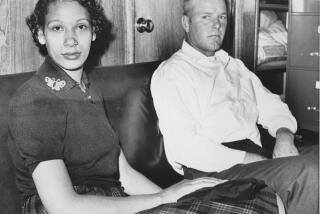The Passions of Presidents on Display at Nixon Museum
- Share via
YORBA LINDA — The year is 1940. Young lawyer Richard Milhous Nixon, not yet infamous for his foul mouth and dirty tricks, is writing a love letter. The recipient is his fiancee, a schoolteacher named Thelma Catherine Ryan, known as Pat.
“Do you remember that funny guy who asked you to go to a so-so ladies’ night about two years ago?” Nixon penned. “Well, you know that though he still may be funny--he’s changed since then.
“And when the winds blow and the rains fall and the sun shines through the clouds (as it is now), he still resolves, as he did then, that nothing so fine ever happened to him or anyone else as falling in love with Thee--my dearest heart.”
A new museum exhibit features written proof that behind the facade of American presidents dwell regular guys madly in love with their wives--mistresses notwithstanding and not mentioned.
“Dearest Partner: Husbands and Wives in the White House” runs through November at the Richard Nixon Library & Birthplace in Yorba Linda. It peeks into the courtships and marriages of 30 presidents and first ladies, revealing endearing nicknames, love-struck prose and heartbreaking loss.
A besotted John Adams called his wife, Abigail, “Miss Adorable.” Putting quill to parchment and abandoning decorum, he demanded kisses before marriage in a letter dated Oct. 7, 1762. Fourteen years later, in the same painstaking hand, he signed the Declaration of Independence.
“By the same token that the Bearer hereof sat up with you last night I hereby order you to give him as many kisses and as many hours of your company after six o’clock as he shall please to demand and charge them to my account,” Adams wrote his intended.
*
Theodore Roosevelt called Alice Roosevelt “my sweetest little wife.” Lonely while campaigning for the New York state Assembly, Roosevelt wrote in 1881, “I so longed for you when I received your darling letter that I could hardly contain my desire to see you. Oh, my sweetest true-love, pray for nothing but that I may be worthy of you.”
On Valentine’s Day in 1884, Alice Roosevelt died after giving birth. The same day, in the same house, Roosevelt’s mother died of typhoid fever. Shattered, he moved to a Dakota Territory ranch and never spoke of his first bride again, not even to their only child, who was named after her mother.
Nixon Library curator Olivia Anastasiadis and first lady biographer Carl Anthony spent two years culling artifacts from universities, the Library of Congress and the private closets of Barbara Bush, Betty Ford and Hillary Rodham Clinton.
Hillary Rodham Clinton sent her wedding gown, which floored Anastasiadis. “I never expected her to part with it,” the curator said. It’s also one of the exhibit’s most popular pieces, in no small part because of its plainness.
Hillary Clinton bought the ivory, floor-length gunnysack dress off the rack of an Arkansas department store one day before her 1975 vows. Standing before it, a recent museum visitor whispered to her husband, “That was the style then. They were all hippies.”
Anastasiadis smiles at such comments. “I just think it’s really indicative of who Hillary is. There’s not a lot of poufs and lace and ruffles about her.”
Visitors sometimes spend hours reading the exhibition’s glass-encased letters. Others are taken by Nancy Reagan’s wedding bouquet, Pat Nixon’s baroque wedding and engagement rings, and an impossibly tiny silk bodice worn by Rachel Jackson.
Dot Jensen, 59, and Eleanor Parris, 63, visited recently while on vacation from Chattanooga, Tenn. History buffs, they pride themselves on the number of presidential libraries each has visited--from Lyndon Johnson’s in Austin, Tex., to Harry Truman’s in Independence, Mo.
This was their first visit to the Nixon Library. They came because of this exhibit.
They also came with the knowledge that presidents aren’t perfect. White House affairs are as old as some of the museum pieces: Warren G. Harding had a mistress, as did Woodrow Wilson and Franklin D. Roosevelt.
“It wasn’t until long after Kennedy died that you heard about him and Marilyn Monroe,” said Jensen. But she had vague suspicions, notably when Monroe squeezed herself into a sequined dress and breathlessly sang “Happy Birthday” to President John F. Kennedy in public.
“At the time, we were saying, ‘Now why is Marilyn Monroe standing up there singing to him like that?’ ” Jensen recalled. “You’d wonder, but you didn’t know.”
Parris said the exhibition made her feel better about the occupants of the Oval Office. “It makes you think, ‘Well, maybe they did love their wives.’ ”
Jensen smiled. “You want to believe that what they say is true, and that they really are romantic, but you never know,” she said. “Sometimes they do just tell you what you want to hear.”
More to Read
Sign up for The Wild
We’ll help you find the best places to hike, bike and run, as well as the perfect silent spots for meditation and yoga.
You may occasionally receive promotional content from the Los Angeles Times.






